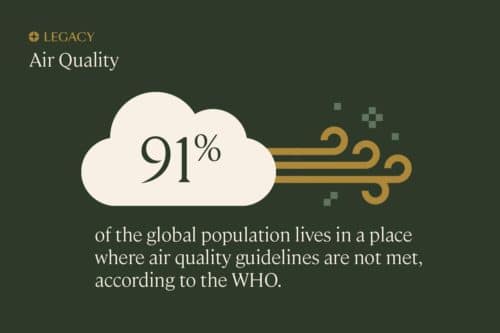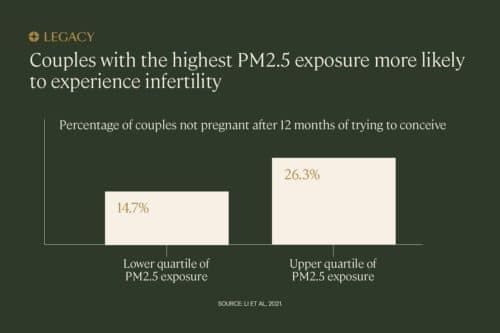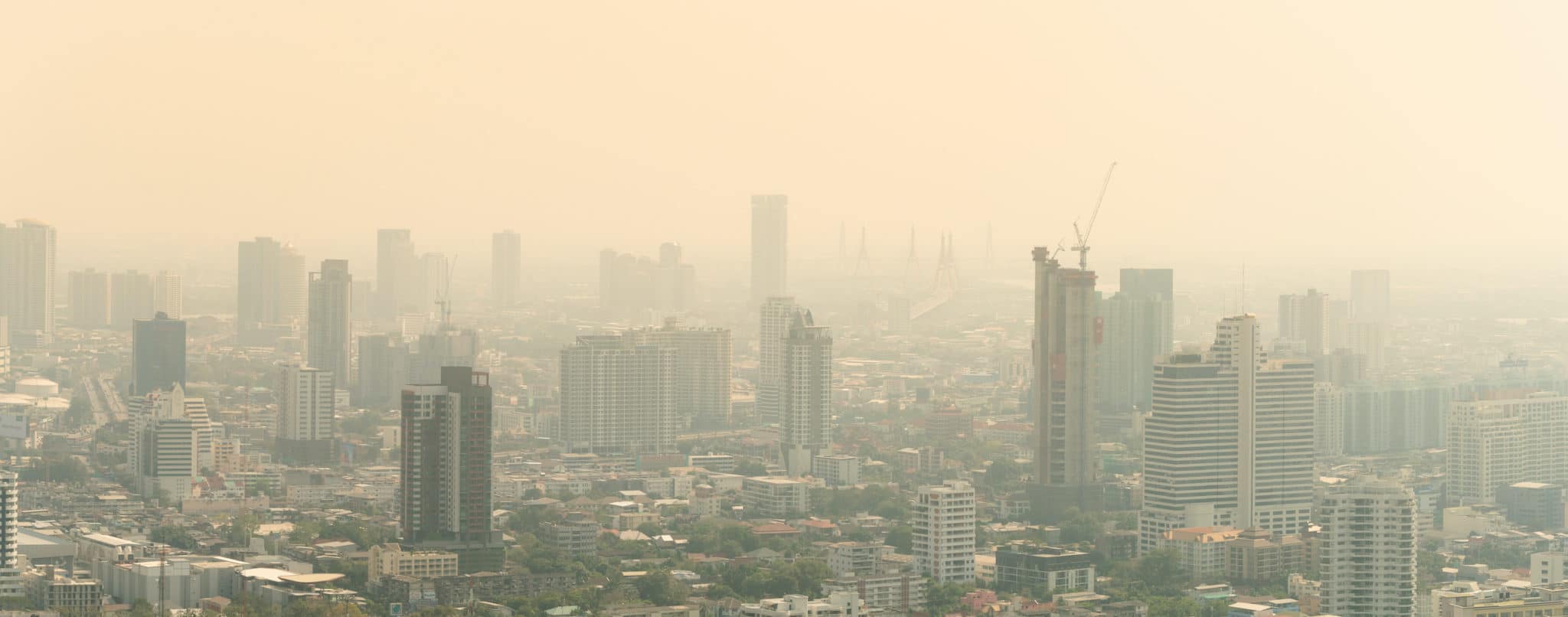A new report analyzing more than 10,000 couples in China found a link between small particle pollution and infertility rates. This report establishes a much stronger link between air quality and fertility rates than studies in the past, but doesn’t answer the most pressing question: why it happens.
Understanding air pollution
The study, and many others, looks at pollution from particulate matter 2.5 (PM2.5). PM2.5 refers to inhalable particles that measure less than 2.5 micrometers. This type of pollution is typically produced by gasoline, oil, diesel fuel or wood combustion emissions. Because they’re so small, these particles can get into your lungs and even your bloodstream, posing significant risks to your health.
The World Health Organization (WHO) considers exposure to PM2.5 safe so long as it doesn’t exceed 10 micrograms per cubic meter of air (μg/m3) on average, over a year. But in cities around the country—and the world—people are exposed to higher levels regularly, simply by virtue of their geographic location. In 2016, the WHO estimated that 91% of the world population was living in places where their air quality guidelines levels were not met.
In 2019, the average PM2.5 level for Bakersfield, CA—considered the most polluted city in the US—was 13 μg/m3, according to the EPA. In the New York metro area, it was 11 μg/m3. In Beijing, it was a whopping 42.6 μg/m3, down from twice that in 2015. Suffice it to say that many of us are being exposed to potentially detrimental levels of air pollution, likely without even realizing it.

The pollution-infertility link
This isn’t the first time researchers have studied the link between air quality and fertility rates. However, this is one of the first times researchers have taken such a large sample from the general population, rather than from those who are already patients at infertility centers
China requires women to register before seeking to become pregnant, so researchers had much easier access to information from couples trying to conceive. Over 10,000 couples participated in the study, which relied on interviews and questionnaires.
The study used remote sensing to estimate a couple’s pollution exposure and controlled for known fertility factors like age, smoking habits, and other lifestyle factors. Researchers discovered that:
- Each 10 μg/m3 increase of PM2.5 decreased fecundity (childbearing potential) by 11%.
- The same increase resulted in a 20% higher likelihood of infertility.
- Couples with the highest exposure to pollution had a 26% chance of not conceiving after 12 months, compared to those with the lowest exposure.

What’s in air pollution?
After National Air Quality Standards appeared in the 1970s, research into the effects of air quality skyrocketed. There are a few different kinds of air pollution.
- Particulate matter: Sulfates, nitrates, carbon, or mineral dusts, vehicle emissions, fossil fuel combustion, even smoke from cigarettes or large fires.
- Noxious gasses: Carbon dioxide, Carbon monoxide, and other gasses that are byproducts of vehicle emissions or industrial processes.
- Volatile organic compounds: Carbon-based emissions given off by paints, cleaning supplies, gasoline and natural gas fuels, and other compounds that vaporize at room temperature.
- Polycyclic aromatic hydrocarbons: Organic hydrogen and carbon compounds known to be carcinogenic. Some are present in particulate matter.
This isn’t an exhaustive list, but it does illustrate the challenges of living in a modern, industrial world while attempting to maintain health. These pollutants affect cardiovascular health, respiratory health, and potentially cause cancer. Whether infertility is a result of these bigger health issues or its own side effect isn’t immediately clear.
Other studies supporting the pollution-infertility link
Researchers have suspected environmental factors were contributing to infertility for years. A 2000 study of 408 young men in the Czech Republic found a link between periods of elevated air pollution and both a decrease in sperm motility and a degradation of sperm morphology. These men continued to have a normal sperm count, but had far fewer viable sperm.
In another study conducted in 2005, researchers confirmed a link between episodic air pollution and sperm DNA fragmentation. Periods of high pollution (at or above the limits of US air quality standards) seemed to cause issues with sperm quality.
Like the 2000 study, researchers looked at episodic air quality for the same town in the Czech Republic. But, whereas the 2000 study used only one sperm sample from each participant, this study looked at sperm quality over a period of two years, sampling seven different times corresponding to when pollution was at its highest and lowest points.
Like the 2000 study, air pollution didn’t seem to affect sperm count. However, this second study confirmed a possible link between higher levels of air pollution and DNA fragmentation.
The effect does not seem limited to male fertility, either. A 2020 study looked at the effects of air quality on women’s fertility, examining 632 women at Massachusetts General Fertility Clinic. The result: Every 2 μg/m3 increase in pollution exposure decreased the lower antral follicle count by −7.2%. Antral follicle count is a measure of the number of eggs that are “activated” each cycle, and serves as a proxy for a woman’s total ovarian reserve. Researchers wrote that the results raise the “concern that air pollution may accelerate reproductive aging.”

Studies still aren’t conclusive
For many past studies, small sample sizes or lack of variety from general populations mean results weren’t airtight.
For example, a meta-analysis of outdoor air pollution and sperm quality conducted in 2016 showed a strong link between air quality and instances of DNA fragmentation or morphology changes, but researchers note:
“…most studies concluded that outdoor air pollution affects at least one of the four semen quality parameters included in the review. However, results lack consistency, and furthermore, studies were not comparable. Studies using standardized air pollution and semen measures are required to obtain more reliable conclusions.”
As a result, researchers and fertility specialists are hesitant to say air pollutants are the primary causes of otherwise unexplained fertility issues.
Why is this important?
Infertility affects one in six couples. We know air pollutants cause higher chances of premature births and low birth weight. Pollutants like nitrogen dioxide have effects similar to secondhand smoke, and may cause miscarriages. Researchers have found pollution particles on the placenta’s fetal side, suggesting that even normal pregnancies could still carry long-term risk from exposure to pollution.
These findings are upsetting. The adverse effects of pollution on male fertility are part of a much larger collection of consequences of continued pollution. Governments and environmental groups are increasingly worried about the long-term consequences of pollution, especially when so much of it is linked to human activity.
A study from Science Alert suggests that half the world’s population is exposed to increasing air pollution despite our efforts to improve air quality. And while the WHO is focusing on mortality rates for those vulnerable populations, the effects on fertility are certainly connected.
What can men do?
Short of moving off-planet or into some deep underground bunker with a high-tech filtration system, men will need to learn how to navigate the health effects of air pollution. Lifestyle changes may help to counteract some of the effects of environmental pollution, which is good news for those of you not planning to move to Mars. It takes about 74 days to make a mature sperm cell, so making lifestyle changes could have a positive effect in only a few months.
- Healthy diet: A study published in 2021 found positive correlations between adopting a Mediterranean diet and fertility outcomes. Men who adopted a four-month Mediterranean diet showed an increase in sperm quality parameters.
- Reduce substances: Smoking, alcohol intake, and illicit drugs all affect sperm quality. Eliminating these influences helps reduce your overall toxic load.
- Physical activity: One study showed a positive correlation between moderate physical activity and greater sperm motility.
If you’re worried about the effects environmental factors may have on your future fertility, private at-home sperm testing can give you the knowledge you need to make choices. You may not have control over worldwide car emissions or industrial processes, but you can take steps to improve what you can.



